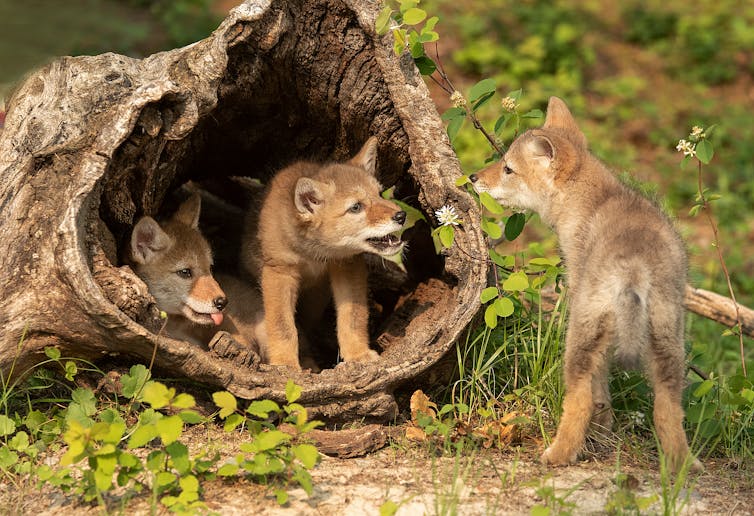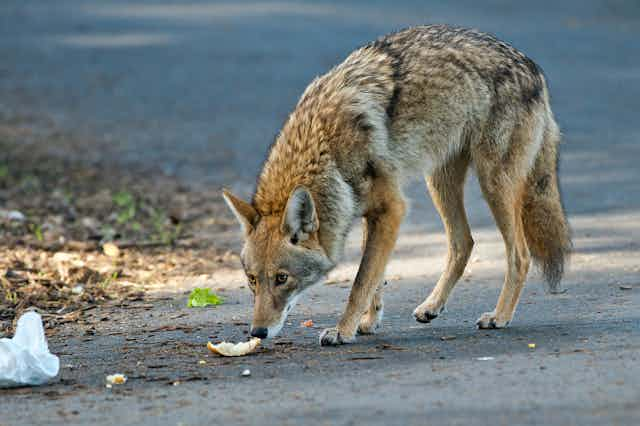On average, three people per year are “attacked” (that means bitten or scratched) by coyotes across Canada. In comparison, an average of 180 Canadians per year are reportedly struck by lightning. Critically, 100 per cent of incidents involving coyotes are linked to human feeding.
I have studied coyotes and other wild canids for over 30 years. Co-existence with coyotes is possible. My understanding comes from many places: being a care-giver to orphaned coyote pups, studying the development of coyote play and communication, helping trap and radio-collar them, supervising multiple theses and, most recently, monitoring a multi-generational coyote family for years. I interact with coyotes at very close range, and sparingly use aversive conditioning, which involves using my voice, body and a held object to establish boundaries.
Distorted risks
I am often asked how citizens can protect themselves against “aggressive coyotes.” In my research, I found that coyotes rarely exhibit aggression, but human fear of coyotes is pervasive and overrides scientific evidence. While sometimes unintended, the use of risk narratives (including misplaced words like bold, aggressive) by scientists or media has the demonstrated effect of tapping into existing fear — this is referred to as the “social amplification of risk.”
People then normalize the idea that coyotes are likely to attack, rather than the more apt narrative: Coyotes are simply trying to survive, preferring to avoid people. When coyotes react, it is to protect themselves, their mates or pups from an actual or perceived threat, like dogs chasing them or coming into a den area, or a person poking at the den with a stick. In the reports that I have reviewed where dogs were attacked, over 90 per cent involved dogs off-leash and at-large.
Coyote reactions stem from context and experience, they are varied and rarely about aggression. Habituation in cities may have led to delayed or less dramatic responses in coyotes, as compared to non-urban coyotes that often desperately flee from humans.
Living in the city
Conflict with coyotes is preventable, but when it occurs, it does so in the context of several human-centred factors. Habituation of coyotes is often the first identified culprit. This means that the coyotes become accustomed to human activities, learn to “tune them out” and direct attention to those things that are more important, like finding food.
In wildlife observational research, scientists often strive for animal habituation so the observer may be in plain sight, yet “invisible,” allowing animals to do what they do. In the absence of immediate threats, coyotes learn to sometimes disregard humans.
Yet, there is this myth that habituation is bad and that coyotes should fear people. But there is no evidence that the natural state of coyotes is to desperately fear humans that are nearby. I believe this line of thinking is a colonial mindset that demands animals to be submissive to humans.
Habituation may lead to proximity issues, which can cause conflict if it is coupled with food conditioning — the intentional or unintentional feeding of coyotes. This arises when people fail to keep yards free of food attractants like dog food, bird seed, fallen fruit or compost. A coyote learns to depend on that food source, which can can increase the risk of the coyote guarding food against people and pets.
What is most catastrophic to co-existence is when people decide to deliberately feed coyotes. That often is a death sentence for the coyote because it can eventually demand food. Coyote demand behaviour may include a coyote latching on to a person’s clothing or limbs in an attempt to get food, and can be mistakenly classified as aggression or attack. Once a coyote has bitten a person, the chances of rehabilitation are low relative to the risk of escalation, and a coyote exhibiting this behaviour would likely be killed.
Several studies about coyote diet in Calgary, conducted in my lab, showed less than two per cent of samples contained pet remains. Coyotes are not fully to blame: the city has a bylaw prohibiting free-ranging pets, which many people disregard, subjecting their pets to possible death by owl, eagle, bobcat, domestic dog, coyotes and vehicles. Coyotes often just scavenge, earning them the label “nature’s clean up crew.”
Dog encounters

Coyote pups are usually born around early April, known as denning season, and coyotes shift into pup-guarding mode. As a result, there can be a spike in conflict between dogs and coyotes, almost exclusively due to a perceived intrusion by a domestic dog.
Coyotes may first warn by standing and staring, this will increase to vocalization, a bluff charge, then an attack on the dog if the owner does not withdraw immediately.
Coyotes in non-urban situations might prefer certain den characteristics (for example, south-facing slopes), but in fragmented green spaces that dot cities, coyotes may be forced to be resourceful – and the more disturbed they are by people or dogs, the more prone the coyotes are to move pups somewhere perceived to be safer.
Last year at one study site, I observed hundreds of people a week, many with dogs, walked right past a father or mother coyote with four pups less than 30 metres away. The parent coyotes were measured, careful and avoided conflict routinely. Over the course of thousands of possible interactions that summer, there were six reports of “aggressive” or “bold” coyote interactions. In these rare cases, a parent coyote either escorted, bluff charged or vocalized to repel dogs that were allowed to wander in closed areas — there were no attacks or injuries.
On the University of Calgary campus, we have a peaceful wildlife co-existence program, based on monitoring and investigation, education, enforcement and mitigation. With the help of supportive staff and faculty, responsive deployment of signage or closures, removal of attractants and the measured use of humane aversive conditioning, our program ensures coyotes and surrounding communities continue to use the campus safely, promoting biodiversity and sustainability in the urban ecosystem.

